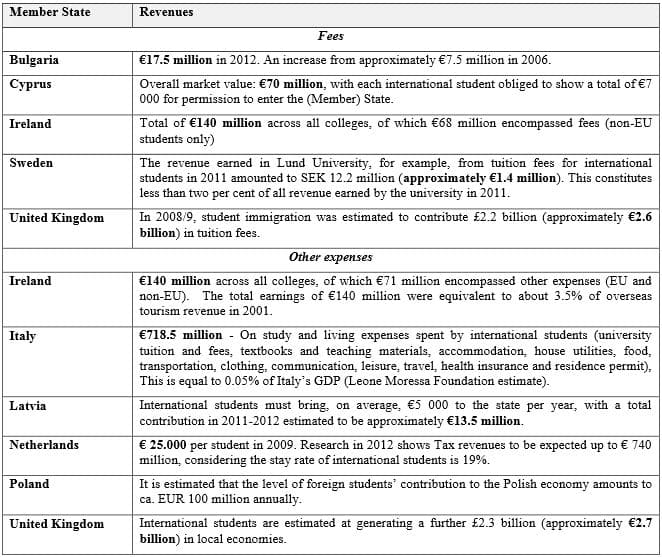Europe takes stock of its international student recruitment strategies
As competition for international students intensifies around the world, the European Union is increasingly interested in promoting member countries – and indeed, the entire Eurozone – as a top study abroad choice. Today’s ICEF Monitor post looks at the findings of several new reports as they relate to trends in participating EU countries’ efforts to attract international students – including work and immigration policies, which are frequently viewed as key elements of a study abroad nation’s competitiveness.
A decade of growth
According to a new report from the European Migration Network (EMN), a body of the European Commission, the number of international students in Europe increased by roughly 114% from 2000 to 2010 – a substantially higher rate than the growth of international students in North America, which was estimated at roughly 55%. The EMN report, entitled “Immigration of International Students to the EU,” was based on contributions from 25 countries including Austria, Belgium, Bulgaria, Cyprus, Czech Republic, Estonia, Finland, France, Germany, Greece, Hungary, Ireland, Italy, Latvia, Lithuania, Luxembourg, Netherlands, Poland, Portugal, Slovak Republic, Spain, Slovenia, Sweden, United Kingdom, and Norway.
International students a substantial part of many EU populations
Overall, the EMN report found that international students compose an important proportion of the non-EU population in many EU countries: 21% of all new first residence permits in the report’s participating countries were issued for education reasons. Despite many countries’ efforts to facilitate the entry of Erasmus students (students from the EU going to other EU countries to study), the report notes that only “1.4% of the total number of first permits issued in Member States in 2011 for the purpose of study” were given to students coming under the high-profile Erasmus mobility programme.
National strategies in use to attract foreign students
In terms of the national strategic goals for wanting to attract international students, the report listed two:
- Attracting skilled students (mostly master and doctoral students) within a wider policy context of attracting highly skilled workers to meet skills shortages in national labour markets;
- Attracting international students for national economies to benefit from the revenue streams associated with these students (e.g., fees, living expenses, etc.).
Strategies used to attract foreign students vary from country to country, and may include:
- Marketing programmes to promote the country as an attractive destination and to provide information to students on available courses and services;
- Scholarship and funding opportunities, often tailored to students from countries with which the host country has a bilateral agreement in place;
- More recently, the introduction or augmentation of English-language courses (already prevalent in The Netherlands and Sweden, others are now prioritising English-medium instruction, including Finland, Lithuania, Poland, Slovak Republic, Slovenia, and Spain);
- Flexible admission procedures;
- Providing freer than usual access to the labour market (e.g., number of hours allowed to work) – but the report noted this was often restricted to low-skilled sectors rather than in sectors that would allow the student to build his/her professional network and expertise;
- Ability to apply for work permits without leaving the country, and even the ability to be self-employed as entrepreneurs.
Many of the countries participating in the study are putting the focus on attracting the “brightest and the best” students … “mostly masters and PhD students who contribute to the knowledge base of specific sectors important to the economy.” Some (Finland, France, Ireland, Luxembourg, Netherlands, Poland, Portugal, and Spain) are setting clear targets for the number of international students they want to attract (e.g., Finland wants to increase the number of foreign degree students by approximately 77% from 11,303 in 2007 to 20,000 in 2015, and Spain is looking to boost its international student population from 4.9% in 2012 to 10% in 2015). Meanwhile, some are targeting specific countries for international students (e.g., France, Luxembourg, and the Netherlands are prioritising BRIC nations, and Portugal favours Portuguese-speaking countries). And others plan to amend their policies on international students. For example, The Netherlands intends to more effectively prevent “misuse of the student route” by setting targets for students and collecting biometric data during the visa application process. “Poland intends to introduce preferential admission and stay regulations for international students and university graduates.” Hungary and Latvia appear to be the only countries without a national policy on international students. In Latvia, each institution determines its own needs and strategies for attracting foreign students. “In Hungary, only an action plan is in place which aims to strengthen the education of ethnic Hungarians living outside the territory of Hungary.”
Survey reveals current internationalisation strategies
Meanwhile, on the subject of strategies, a recent survey on the state of internationalisation in higher education by the European University Association (EUA) of 175 HE institutions in 38 countries found that “more than half (56%) have an internationalisation strategy in place and a further 13% intend to develop one or have considered internationalisation in other strategies.” The survey revealed the following internationalisation strategies currently used by HE institutions:
- development of new partnerships with new regions and countries (73%);
- sending more students abroad (72%);
- growing the international student population (68%);
- offering international opportunities to staff (67%);
- offering more courses in English (67%);
- developing double and joint degrees (61%).
The survey found that the most popular priorities for action were:
- attracting students from abroad (30%);
- internationalisation of learning and teaching (19%);
- providing students with more opportunities to have a learning experience abroad (12%);
- strategic research partnerships (10%).
Three variations in university-level promotional efforts
In order to execute some of these strategies, universities in EU countries may be conducting their marketing...
- by themselves - often via scholarships or including offers of free or discounted services. For example, the EMN report notes that the University of Luxembourg provides free lodging to Chinese students.
- with another institution. The EMN report provides the example of the Spanish-Moroccan cross-border campus between the University of Cadiz and Abdelmalek Essaâdi University.
- in collaboration with the university sector in the country as a whole. For example, in The Netherlands there is a Code of Conduct agreed to by the joint institutions of higher education that is promoted to international students to signal a sector-wide commitment to excellent education for international students.
Waving the job flag
The EMN report assesses that there are two types of policies in place in the participating EU countries regarding employment after graduation for international students:
- Member states that only allow international students to stay if they have a job or are continuously employed (Belgium, Cyprus, Spain, Estonia, Italy, Latvia, Lithuania, Poland, Slovak Republic, Sweden, and United Kingdom);
- Member states that allow international student graduates to stay in order to search for a job (Austria, Germany, Finland, France, Ireland, Luxembourg, Netherlands, Portugal, Slovenia, Norway).
An example of the impact of the second type of policy – allowing international students to remain in the country post-graduation to find work – can be found in Finland, which allows international students to remain to seek employment for a period of six months after graduation. In 2007, 73% of foreign students who remained in Finland found work. For further details on this topic, please see our article from last year, which gives an overview of the intentions of 6,200+ international students at 25 universities in Germany, France, the UK, Netherlands, and Sweden.
The economic contribution of international students
Despite the economic contribution of international students, actual revenues realised thanks to foreign students vary due to the different types of educational systems across the countries. Some, for example, offer free access to education and low student fees.
The EMN report provided a table that shows the sources of international student revenues for select participating countries:

Immigration prospects important to study market attractiveness
Right at the outset, EMN’s report makes it clear that increasingly, the countries that provided data for the study are well aware of international students’ potential to remain in the country and add needed workforce skills. And it moves on to declare: “States with a more flexible policy [on allowing international students to work during and after study] might be considered as more 'attractive'.” It seems, from the growing number of non-EU international students choosing EU countries to study in, that both national-level and institutional-level strategies are on the whole working well to attract students from outside the EU. Looking for room for improvement, the report concludes:
“The overall aim of improving EU and national strategies and policies is to ensure that the EU can be considered as a world centre for excellence in education. Further legislative action at the EU level, aiming to provide for further improvements in admission conditions, rights during stay, including mobility, and ensuring safeguards for third-country nationals, in line with Treaty objectives, is likely to make an important contribution to delivering this objective.”
Tourism sector a signal of Europe's strength
The EMN report and EUA survey arrive at the same time as two more pieces of research; the first being the United Nations World Tourism Organization's (UNWTO) new "World Tourism Barometer." Results show that international tourist arrivals in Europe were up by 3% in 2012, a “very positive result in view of the economic situation.” UNWTO Secretary-General Taleb Rifai said of the modest growth in European tourist arrivals: “2012 saw continued economic volatility around the globe, particularly in the Eurozone. Yet international tourism managed to stay on course.
The sector has shown its capacity to adjust to the changing market conditions and, although at a slightly more modest rate, is expected to continue expanding in 2013. Tourism is thus one of the pillars that should be supported by governments around the world as part of the solution to stimulating economic growth.”
Zeroing in on the continent, the European Travel Commission's (ETC) latest "European Tourism in 2013: Trends & Prospects" report indicates that "international arrivals and nights to Europe for the first quarter of 2013 point to a slower, but continued growth for most of the reporting destinations." Like tourism, international education seems relatively resistant to shocks to the overall economy, but as emerging economies and developing markets continue to advance in both sectors, Europe will need to fight harder to remain a competitive and attractive destination.
















